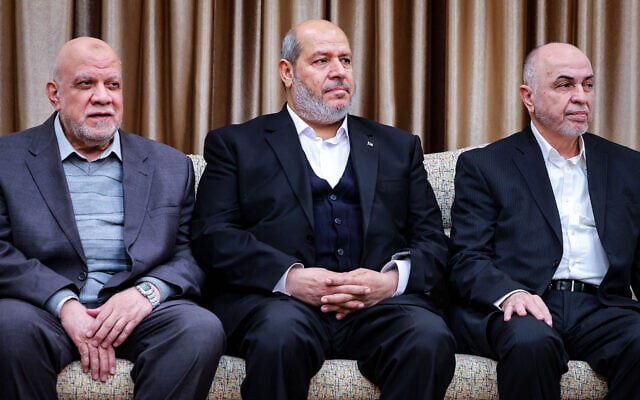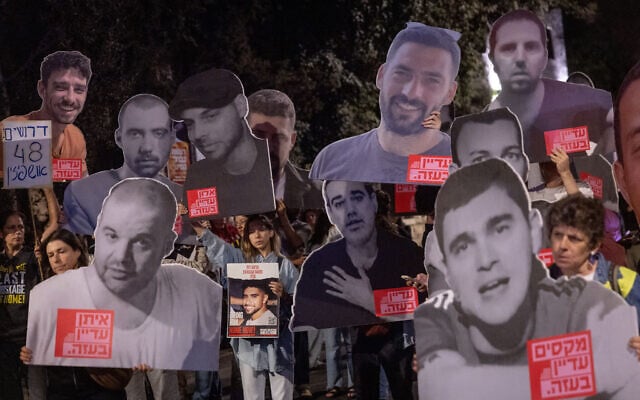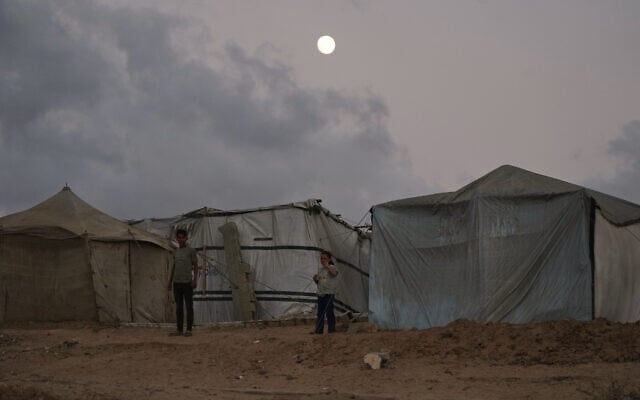


A delegation of Hamas officials led by the terror group’s leader Khalil al-Hayya arrived in Egypt on Sunday night to begin negotiations on Washington’s plan to end the war in the Gaza Strip and free the remaining hostages, as US President Donald Trump implored all parties to move fast toward an agreement.
Israel’s delegation, led by Strategic Affairs Minister Ron Dermer, also departed for Cairo on Sunday night, even as Prime Minister Benjamin Netanyahu was still attempting to keep his right-wing coalition allies on board with Trump’s ambitious 20-point plan and prevent them from jumping ship and bringing down his coalition.
Disapproval within Netanyahu’s coalition is not the only obstacle to reaching an agreement: Hamas has said it is prepared to release the hostages it is holding, but is expected to make additional demands regarding the Israeli military’s withdrawal from the Strip and the release of Palestinian security prisoners in exchange for the hostages.
According to Trump’s plan, Israel is expected to release 250 Palestinian prisoners with life sentences and more than 1,700 detainees from the Gaza Strip who were arrested after October 7, 2023.
The sides have not agreed on which prisoners will be released, although Channel 12 news reported on Sunday evening that Hamas was demanding the release of several of the most notorious Palestinian prisoners held by Israel.
Hamas “won’t give up” on securing the release of these terrorists, Channel 12 quoted a Hamas source as saying, “even at the cost of dooming the deal.”
The terror group, on Sunday night, confirmed that it had arrived in Cairo “to begin negotiations on mechanisms for a ceasefire, withdrawal of occupation forces, and prisoner exchange.”
Despite the non-insignificant bumps that can be expected on the road to an agreement, Trump struck an upbeat tone on Sunday night, saying that there had been “very positive discussions” between Hamas and Arab and Muslim interlocutors over the weekend aimed at securing the release of the hostages, ending the war in Gaza and achieving “PEACE in the Middle East.”
“These talks have been very successful, and proceeding rapidly,” Trump wrote on Truth Social, adding that “technical teams” will meet again on Monday in Egypt to “work through and clarify the final details.”
“I am told that the first phase should be completed this week, and I am asking everyone to MOVE FAST,” Trump said, although it was not immediately clear what he meant by “first phase” and whether he was suggesting that hostages will begin being released this week.
“I will continue to monitor this Centuries old ‘conflict,'” the president said, and reiterated his warning to Hamas to act speedily in an all-cap addendum at the end of his post: “TIME IS OF THE ESSENCE OR, MASSIVE BLOODSHED WILL FOLLOW — SOMETHING THAT NOBODY WANTS TO SEE!”
He later told reporters outside the White House that the effort to secure the agreement “looks like it’s working,” but cautioned that the US would “wait for a little while, [and] see how it all turns out.”
“I think it’s going to go very quickly. We’ll let you know soon,” the president added.
Among the requirements laid out in Trump’s plan for the Gaza Strip is a demand for Hamas to disarm. As to how this will play out, however, “must be addressed within a Palestinian framework,” Egyptian Foreign Minister Badr Abdelatty said on Sunday.
Speaking to the Saudi Asharq al-Awsat newspaper, he expressed hope that the Palestinian Authority’s security apparatus would assume the task of controlling Gaza after an unspecified transitional period, framing the possibility as a political horizon toward the establishment of a Palestinian state.
He said Cairo was also seeking to define the limits of authority for the international force expected to enter the Strip under the plan, and noted that, eventually, the same force would also need to enter the West Bank to link the two areas — Gaza and the West Bank — and to support the Palestinian Authority’s security mechanisms.
The Palestinian Authority’s future involvement in the governance of the Gaza Strip and the potential path to Palestinian statehood are the two key issues that Netanyahu’s far-right allies have taken issue with.
But on Sunday evening, Channel 12 reported that Otzma Yehudit leader Itamar Ben Gvir and Religious Zionism chair Bezalel Smotrich had given the premier leeway to facilitate at least the implementation of the first phase of Washington’s plan, and would not bring down his government over the matter, or at least, not yet.
The two demanded assurances from Netanyahu that Israel would be able to continue to fight Hamas if the terror group does not disarm in the second phase of the agreement, the outlet reported, citing sources familiar with the matter.
The first stage of the proposal, as it currently stands, will enable the release of all 48 remaining hostages, the living and the dead, and will require the IDF to redeploy to positions that allow it to continue to oversee Gaza. In the second phase, Hamas will be required to disarm and Gaza will be demilitarized.
In their meeting with the premier yesterday, National Security Minister Ben Gvir and Finance Minister Smotrich focused on the second phase of the deal, Channel 12 reported, and sought “explicit guarantees” from Netanyahu that Israel would be able to resume fighting if Hamas refused to disarm.
Netanyahu reportedly gave the ministers the impression that if Hamas does not disarm, Israel will be able to act — though such a guarantee does not appear anywhere in the US proposal’s current 20 points.
Despite this, anonymous sources said that the two men left the meeting feeling that Netanyahu had not provided sufficient assurances on the issue. Still, they decided that for the time being, they would give him more time to carry out the agreement, but warned that they would not tolerate Hamas restoring its capabilities in Gaza.
Ben Gvir had said the day before that his faction would leave the government if Hamas “continues to exist” after the hostages are returned.
On top of the pressure at home from his far-right allies, mounting reports have suggested that Netanyahu is also facing pressure abroad, from none other than Trump himself.
Reports of tensions between the two men began to emerge after Trump welcomed Hamas’s response to his proposal on Friday night, in a move that was said to have caught Netanyahu off guard, as he had been preparing to declare the terror group’s response to be a rejection of Trump’s offer.
The disagreement over whether Hamas had accepted or rejected Trump’s plan led the US president to rebuke his Israeli counterpart, telling him in a tense phone call on Friday to not be “so fucking negative,” the Axios news outlet reported Sunday.
According to a US official, Netanyahu had told Trump the ambivalent Hamas response, which welcomed parts of the proposal while hinting at disagreements over other sections, was “nothing to celebrate.”
Adding fuel to the fire, Trump shared a New York Times article on Truth Social on Sunday, which detailed how fury over Israel’s botched strike against Hamas leaders in Doha last month led him to pressure Netanyahu to end the war.
Trump did not offer any commentary when sharing the story on Truth Social, but the decision to do so further bolstered the narrative about how the US president has lost patience with Netanyahu.
The Prime Minister’s Office has sought to downplay the notion, insisting that the two are on the same page regarding Trump’s Gaza plan.
With top negotiators gathering in Cairo and Trump predicting a swift procession to the deal’s implementation, the mood on the ground in both Israel and Gaza was tense, yet still hopeful.
In Israel, relatives of the hostages gathered with former hostages and bereaved relatives at Tel Aviv’s Hostages Square to pray and sing together and express their hope for an end to the two-year-long nightmare they have experienced.
Julie Kuperstein, the mother of hostage Bar Kuperstein, said she “can’t get excited yet,” while Sigi Cohen, the mother of former hostage Eliya Cohen said she felt in her heart that the stage at Hostages Square would no longer be needed by next week.
Sasha Trufanov, who was released from captivity in February 2025, spoke to the crowd about the power of the High Holidays — Rosh Hashana and Yom Kippur — and was joined by fellow freed hostage Agam Berger, who performed the liturgical prayer “Ana b’Koach,” on her violin.
Elhanan Danino, the father of Ori Danino, who was killed by his captors in the tunnels of Gaza in August 2024, spoke about Yom Kippur in general, and the liturgy that reflects the great losses and trauma suffered by Israel on October 7, 2023.
“Enough, God Almighty, have mercy on your nation who are calling to you,” said Danino.
He noted that while those marking the Yom Kippur fast went home to full refrigerators to sate themselves after the 24-hour fast, the hostages have been fasting for more than 15,000 hours.
“They don’t know what date it is. They don’t know the hour. Every day is Yom Kippur for them,” said Danino. “If we can’t bring them home with ammunition, let’s use our prayers so that the living will sit in the sukkah with their families and the others will be brought to a proper burial.”
In Gaza, too, Trump’s plan has stirred hope for peace, but there was no let-up of Israeli attacks on Sunday, as planes and tanks pounded areas across the enclave, killing at least 19 people, local health authorities said.
Four of those killed were seeking aid in the south of the strip and five were killed in an airstrike in Gaza City in the early afternoon, they said.
The figures could not be verified.
Still, Muin Abu Rajab, 40, a resident of the city’s Al-Rimal neighborhood, told AFP that there had been “a noticeable decrease in the number of air strikes” since the previous day, when the IDF was instructed to move to defensive operations only.
“The tanks and military vehicles have slightly pulled back, but I believe this is a tactical move, not a withdrawal,” he said.
Ahmed Assad, a displaced Palestinian man in central Gaza, said he had been hopeful when news broke of Trump’s plan but said nothing had changed on the ground.
“We do not see any change to the situation, on the contrary, we don’t know what action to take, what shall we do? Shall we remain in the streets? Shall we leave?” he asked.
Times of Israel staff and agencies contributed to this report.






